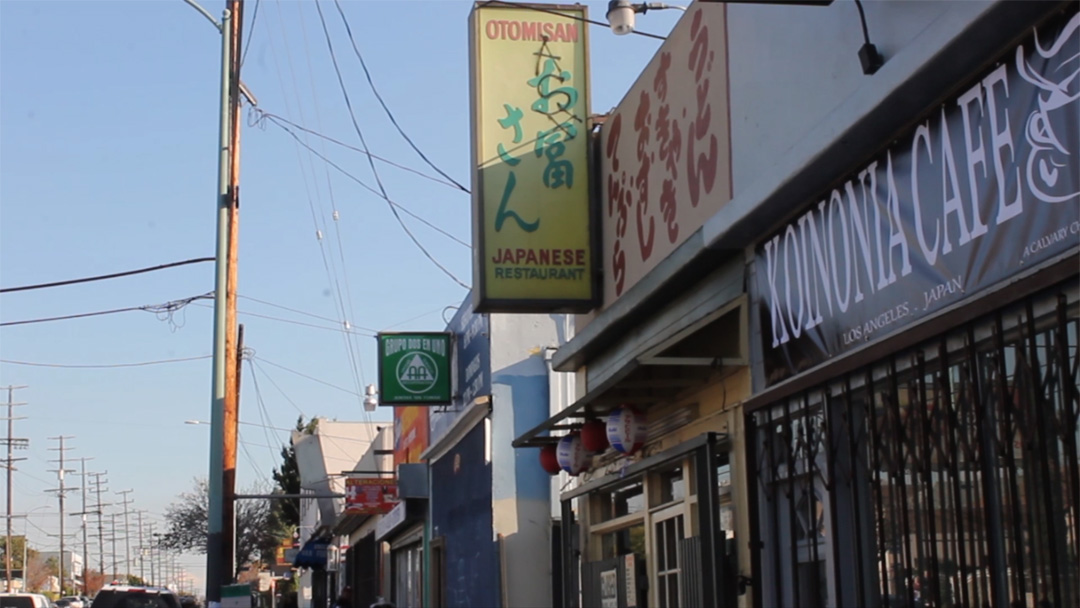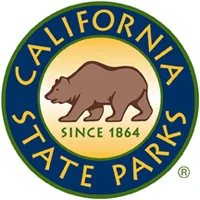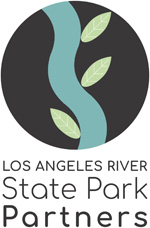Establishing Shots:
Visions of Los Angeles on Video
Thursday, August 16, 2018
8pm
Los Angeles State Historic Park
Los Angeles is not only the center of the filmmaking world but also — and because of that — “the most photographed city in the world.” And yet, as Thom Andersen made clear in his landmark documentary Los Angeles Plays Itself, it is a city that the moving image rarely gets right. It is too often distorted, fractured, or erased in service to some other story or idea. Establishing Shots brings together a number of mostly-recent video works that take Greater Los Angeles — its life, landscape, and memory — as their subject matter. While deploying a diversity of strategies and forms, each approaches a kind of truth about the city, from objective, factual histories to senses of experiential, speculative wonder.
In the former group is Gregorio Davila’s Nancy from Eastside Clover, in which we meet Nancy Valverde, an 84-year-old, butch, Chicana lesbian from East L.A. that was repeatedly harassed and arrested by the LAPD in the 1950s under the discriminatory “Masquerading Law.” Similarly, in filmmaking collective Form follows Function’s Traces No. 1: Youth Break Center, Inc./Radiotron, the story of pioneering West Coast hip hop mecca Radiotron is told by artist, activist, and founding director Carmelo Alvarez. Donuts, by Natasha Masharova, takes a fly-on-the-wall approach to introducing the “donut” scene, where car lovers of South L.A. reclaim the streets for some unauthorized automotive fun. Tolu Awosika’s series of short “street cinematography” videos transfer the roving, curious eye of street photography to the moving image, capturing moments in quotidian places that often go unnoticed. Will Geary’s Los Angeles Transit Flows uses data-processing to visualize the daily dance of transit trips across the city. In the Cradle of Los Angeles episodes of the Tom Explores Los Angeles series, Tom Carroll gives us a first-person historical tour of the very park where the screening is being held — one he knows intimately from his years as a guide at the park.
On the more experiential side of things, we find Jimmy Marble and Adi Goodrich’s Beneath the Pavement, Beach! It uses green screen techniques to pierce the city’s surface and bring to life the Situationist slogan from which the video gets its title. While Goodrich and Marble find light and magic, in her sonic study of Mount Wilson, Finer Frequencies, Sara Suarez finds a foreboding darkness and perhaps hints to the possibility of EVP in the hills looming above us.
But many of the videos fall somewhere in the middle. In Anna Luisa Petrisko’s MABUHAY KA, three Filipinas meditate on their place within Historic Filipinotown through ritual and song. The video both literally welcomes the viewer, as the title — which one of the performers weaves into a fence at the iconic intersection of Temple and Belmont — is a Tagalog greeting, but there is also something elegiac about their exploration of the gentrifying neighborhood. Brian Smee’s Big Surf tells the story of the infamous St. Francis Dam disaster of 1928, but in a beautifully loose, impressionistic way, via a collage of animated drawings, photographs, and archival audio. Arturo Romo and Sesshu Foster’s Movie Version: “Hell to Eternity” uses an actual case of Hollywood whitewashing as a jumping off point for a poetic exploration of the myriad ways the popular representations of place and history are but pale approximations. And, in Labors of Landscape, a video documenting a collaborative installation by Zachary Tate Porter, Christina Novakov-Ritchey, and Mari Beltran, Palos Verdes is examined through research and writing but also, importantly, through performance, through doing, by getting one’s hands a little bit dirty, opening up as many questions as it provides answers.
Which is not to privilege one form over any other. For, indeed, each strategy exists as a kind of corrective to the others — life is not only wonder or speculation any more than it can be reduced to just the facts. Los Angeles, like all cities, is an infinite city, with as many stories and perspectives as it has people. And, given its complexity and sprawl, it is maybe a bit more infinitely infinite than most places. We present here just a few angles from which it may be seen.
Tom Explores Los Angeles: Cradle of Los Angeles, Parts 1–4
Tom Carroll
2017, 10:42 minutes
Los Angeles State Historic Park is a 32-acre green field on the edge of Chinatown. For most of time, it was a floodplain where wild roses and grapes grew; then it was farmland; then a rail yard. Now, it is LA’s newest park. This park and its surroundings are the cradle that Los Angeles grew out of. People over 1000’s of years have been pulled to this area — but why?
Directed, edited, written, and produced by Tom Carroll
Director of photography: Jordan Black
Drone photography: Alex Potter
Sound recording: Matthew Cheek
Extra special thanks: Kailee McGee & Rich Costales
Special thanks: Stephanie Campbell, Collin Campbell, Sean Woods, David Lawrence, Derrick Deblasis, Claire Evans, Jona Bechtolt, Alexis Rivera, Glass Candy, Jeffery Brodsky
Beneath the Pavement, Beach!
Jimmy Marble & Adi Goodrich
2012, 5:46 minutes
Traveling from the sea to city center — and exploring the portals between the two — we pierce the surface of Los Angeles and find the magic revealed within.
Original Music by Ryder Bach
Skateboarding by Andrew Meredith
Labors of Landscape
Zachary Tate Porter, Christina Novakov-Ritchey, & Mari Beltran
2017, 7:06 minutes
The Palos Verdes Peninsula is defined by both its natural beauty and its physical barriers. Situated alongside a scenic coastline, many streets in the neighboring cities of Rancho Palos Verdes and Palos Verdes Estates are privately owned, with vehicular and pedestrian access controlled through a series of gates. The planning for this region began in the early 1920s, when a team of landscape architects representing the Olmsted Brothers traveled from Brookline, Massachusetts, to survey the coastal terrain and design a new community from the ground up. Yet, while the Olmstedian landscape is often associated with democratic and egalitarian values, it has been converted into a luxury aesthetic on the peninsula. It is a landscape of contradiction. There are diverse landforms but homogenous populations, expansive views but restricted entry, ineffable beauty but invisible labor. Yet, something else lies beneath the surface of this surreal tranquility. As the site of three ancient landslides, the Palos Verdes Peninsula is home to some of the most unstable terrains in the world. Here, the geological intertwines with the social, the cultural and the economic, resulting in a complex weave that embodies contemporary theorizations of the Anthropocene.
Documentation of a collaborative installation produced for One Night Stand–Los Angeles (ONS-LA), May 20, 2017.
Los Angeles Transit Flows
Will Geary
2017, 2:00 minutes
Transit networks with higher frequency and shorter waiting times yield a more reliable and empowering experience for passengers than those with lower frequency and longer waiting times. Analyzing transit frequency in an intuitive way, however, can be difficult. Static transit maps provide geographic context but do not give any information about frequency. Timetables provide information about frequency but can be overwhelming, unintuitive, and lacking geographic context. Los Angeles Transit Flows uses spatial-temporal visualization to combine the spatial information of a static transit map with the temporal information of a timetable and make it easer to think and talk about transit frequency.
Data from Transitland, an open-source data service sponsored by Mapzen that aggregates transit networks around the world
MABUHAY KA
Anna Luisa Petrisko
2015, 9:40 minutes
In the gentrifying neighborhood of Historic Filipinotown, three Filipinas meditate on their relationship to diaspora and place, through ritual, song, dance, seed-planting, and offerings. Using the ancient pre-colonial Baybayin script and harvested palm fronds, artist/performer/activist Diyan Valencia weaves MABUHAY KA into a fence at the iconic intersection of Temple and Belmont — Mabuhay, a typical Tagalog greeting that means welcome or cheers, and KA, the word for you, which also signifies connection and communion as in KApwa, KApatid, KAlibutan.
Shot, directed, and edited by Anna Luisa Petrisko
Starring Diyan Valencia, Micaela Tobin, and Emanuele Nedelcu
Additional Cameras by Kristof Trakal, Nicanor Evangelista Jr., and Louvic Cabrera
Made while in residence at Echo Park Film Center, 2015
BMPCC + Panasonic 12–35mm
South Gate — Pinhole Photography
Street Taco — Digital Bolex
Tolu Awosika
2015–2018, 2:21, 1:19, & 1:36 minutes
Camera/technique tests become an occasion to explore and celebrate quotidian spaces that often escape our attention.
Nancy from East Side Clover
Gregorio Davila
2017, 7:49 minutes
Nancy Valverde, an 84-year-old, butch, Chicana lesbian from East L.A., tells her story of being repeatedly harassed and arrested by the LAPD in the 1950s under the discriminatory “Masquerading Law,” which forbade the wearing of clothing typically associated with the opposite sex.
This short was born out of an interview for the in-progress documentary, L.A. A Queer History.
Movie Version: “Hell to Eternity”
Arturo Romo & Sesshu Foster
4:10 minutes
Guy Gabaldon, born in 1926 and raised in East L.A., shined shoes on skid row from the age of ten. At twelve, he moved in with the Nakano family of Boyle Heights, where he learned Japanese. When the Nakanos were sent to camps in Arizona, 17 year old Gabaldon joined the marines and used “backstreet Japanese” to capture 1,500 Japanese troops on Saipan. In the movie version, he was played by a white actor named Jeffrey Hunter, who suffered a stroke at age 42 in 1969 and died falling down the stairs.
Traces No. 1: Youth Break Center, Inc. / Radiotron
FORM follows FUNCTION
2011, 7:37 minutes
The Youth Break Center, Inc., AKA “Radiotron,” was once known around the world for its pivotal role in the West Coast hip hop movement. The Center gained its reputation for being a safe space for breakdancing, popping, graffiti art, MCing, and DJing during the mid-80s when hip hop itself was still in its formative years. For a brief moment in time, the youth of MacArthur Park, and greater Los Angeles, had a haven for creativity that reflected a sign of the times. Carmelo Alvarez, an artist, youth/culture advocate, MacArthur Park local, and founding Director of the Center, takes us back to how it started, how it ended, and provides context on its role in the community.
Produced by Form Follows Function Media
Directed by Maya Santos & Rani de Leon
Edited by Maya Santos
Camera: Maya Santos, Rani de Leon, and Joel Quizon
Sound Recordist/Designer: Rani de Leon
Special Thanks: Carmelo Alvarez, Rukshana Singh, Visual Communications, Juan Devis, KCET Departures, Village Archives, Nik Nikam, Julie Munsayac, and Richard Hama
Archive footage provided by Carmelo Alvarez
Big Surf
Brian Smee
2017, 7:37 minutes
San Francisquito Cyn, March 12th, 1928: The sound a horse makes as it’s drowning. Minutes before midnight, the St. Francis Dam fails. It takes five and a half hours for the dam water to wash out to sea, taking with it hundreds of souls.
Picture and direction by Brian Smee
Sound by Annapurna Kumar
Painting and text by Isabelle Aspin
Prayers by Therese Cleary
Sound mixing by Craig Smith
Translation by Patricia Luna
Finer Frequencies
Sara Suarez
2016, 2:39 minutes
A sonic study of Mount Wilson, its radio towers loom over us like dark, decidedly unsilent sentinels.
Donuts
Natasha Masharova
2016, 13:15 minutes
Every Sunday hundreds of people take to the streets and highways of South Los Angeles, of Compton and Inglewood, making spontaneous yet organized stops, taking over the crossroads, swinging their cars, making donuts, having nice family time, and enjoying the free show — made by people, for people. Everyone is welcome, no matter race, age, gender, or gang membership. Everyone in this Sunday community is connected by passion and love to the DONUT. And here you have the only villain and uninvited guest — the police — playing their role in the entertainment nonetheless.
Filmed and edited by Natasha Masharova
Additional editing by Anatoli Ulyanov
Production: VVHY Visual Lab
Music by Johann Strauss II — The Blue Danube Waltz
This event is presented in collaboration with:














